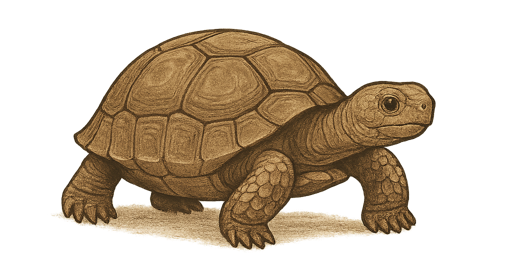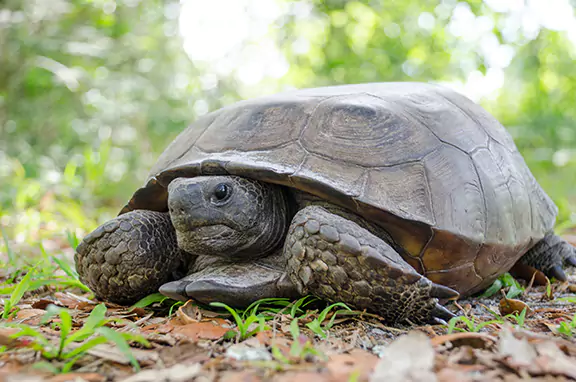The gopher tortoise (Gopherus polyphemus) is more than just a quiet, slow-moving reptile wandering through the sandy uplands of the southeastern United States—it’s a keystone species whose survival supports hundreds of other animals. Found in dry, well-drained sandy soils across Florida, southern Georgia, and parts of South Carolina, these ancient tortoises have been shaping ecosystems for millions of years.
Recognized as a threatened species by the Florida Fish and Wildlife Conservation Commission (FWC) and under review by the U.S. Fish and Wildlife Service for possible federal protection, gopher tortoises are at the heart of ongoing wildlife conservation efforts across the southeastern coastal plain. From their deep, life-sheltering burrows to their critical role in longleaf pine ecosystems, understanding these animals is essential for protecting Florida’s natural heritage.
In this article, we’ll explore what makes the gopher tortoise unique—from its habitat and behavior to its conservation status—while also busting some common myths.
Physical Characteristics and Behavior of the Gopher Tortoise
The gopher tortoise is easily recognized by its domed, dark brown shell, sturdy limbs, and powerful claws built for digging. Adult tortoises typically range from 9 to 15 inches in length, though juvenile tortoises—those under five years of age—are significantly smaller and lighter in color. These hatchlings emerge from eggs in late summer or early fall, and eggs hatch after an incubation period of 80 to 100 days.
One of the tortoise’s most distinctive features is its elephantine hind feet, which help it navigate the dry, sandy terrain of its native upland habitats, including pine flatwoods, xeric oak hammocks, and coastal dunes. Gopher tortoises are considered opportunistic grazers, feeding on broadleaf grasses, legumes, and various native plants. This diverse diet supports their long lifespan, which can exceed 60 years in the wild.
Juvenile Gopher Tortoises
Juvenile gopher tortoises are especially vulnerable to predators like raccoons, fire ants, and birds of prey. Without the hard shell protection of adults, many young tortoises don’t survive to adulthood, contributing to ongoing population declines in fragmented or disturbed habitats.
Gopher tortoises are also known for their solitary nature. While they may overlap in range with others, each tortoise typically maintains its burrow, which it digs using strong forelimbs and claws. These deep burrows—often extending more than 10 feet underground and 40 feet in length—are used year-round for shelter, thermoregulation, and protection from predators.
Understanding these physical traits is essential not just for identification but also for proper gopher tortoise conservation, especially when planning land development projects that could disturb critical habitat.

Habitat – Where Gopher Tortoises Reside
Gopher tortoises thrive in dry, open environments with abundant sunlight and low-growing vegetation. These habitats are typically defined by well-drained sandy soils, which make it easier for tortoises to dig their characteristic deep burrows. The most suitable landscapes include longleaf pine forests, pine flatwoods, xeric oak hammocks, sandhills, and coastal dunes—each part of the broader upland habitat mosaic that stretches across the southeastern United States.
Historically, the longleaf pine ecosystem dominated the southeastern coastal plain, creating ideal conditions for gopher tortoises. Frequent natural fires (or today, prescribed fire) helped maintain open canopies and a healthy understory of grasses and herbs—exactly the environment gopher tortoises need to forage and burrow effectively. Where the fire is suppressed or invasive species take hold, these critical habitats often degrade, making them less suitable for tortoise survival.
How Far Does the Gopher Tortoise Habitat Extend?
The current gopher tortoise range extends from the Florida Panhandle and southern South Carolina, west to the eastern portion of Louisiana, and as far north as the southern edges of the Mississippi River region. However, population density and habitat quality vary widely across this range. In Florida, where most of the remaining populations occur, habitat loss from urban development, road construction, and agriculture has led to significant declines.
Gopher tortoises are particularly sensitive to habitat fragmentation. Because they rely on local resource abundance and suitable soil types to dig burrows, they are unlikely to move far from their home ranges. Habitat degradation can, therefore, have a lasting impact on local populations, especially when combined with other threats like upper respiratory tract disease or increased predation.
To support healthy gopher tortoise populations, landowners and conservationists are increasingly restoring longleaf pine sandhills and managing invasive species. Maintaining open canopy cover and preserving patches of natural, sandy terrain is key, not only for the tortoises themselves but for the many other species that depend on their burrows for survival.
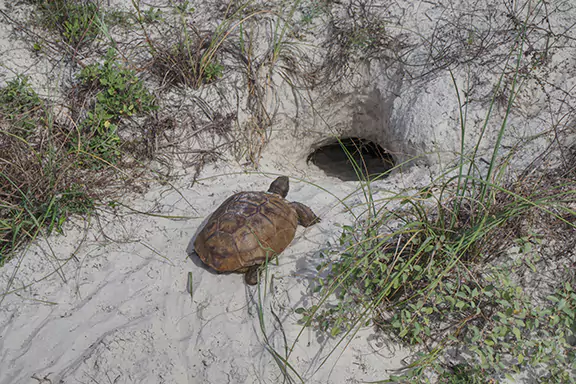
Gopher Tortoise Burrows – Life Below Ground
If you spot a gopher tortoise on land, chances are high that there’s a burrow nearby. Digging burrows is one of the gopher tortoise’s most essential behaviors, making this species such a vital part of the southeastern ecosystem.
A typical gopher tortoise burrow can reach depths of up to 10 feet and extend more than 40 feet in length. These deep burrows are dug into sandy soils using the tortoise’s powerful forelimbs and claws. They serve as a year-round refuge, helping the tortoise escape extreme temperatures, drought, fire, and predators.
Gopher Tortoise Habitat Conservation Benefits Other Threatened Wildlife
But gopher tortoise burrows are more than just personal shelters—they’re lifelines for biodiversity. Over 350 different species are known to use abandoned or active burrows for shelter or nesting, including gopher frogs, burrowing owls, indigo snakes, toads, small mammals, and even insects. This is one of the reasons gopher tortoises are classified as keystone species: their presence directly supports a wide range of threatened wildlife.
The burrow’s structure is designed for survival. The entrance is typically shaped like a tortoise—wide and flat at the base. The interior maintains a relatively stable temperature and humidity, protecting the tortoise from environmental stress. Juvenile tortoises tend to dig smaller, shallower burrows and may abandon them more frequently as they grow or if resources shift.
Collapse of Gopher Tortoise Burrows Endangers Entire Ecosystems
However, burrows are also highly vulnerable to human activity. Development, heavy machinery, and even foot traffic can lead to the collapse of gopher tortoise burrows, sometimes killing the tortoise or trapping it underground. Because of this risk, Florida law prohibits disturbing or filling in gopher tortoise burrows without proper authorization from the Florida Fish and Wildlife Conservation Commission.
Understanding where and how burrows are used is also essential for conservation planning. Surveys to locate active burrows are often required before any development can proceed, and relocating tortoises is a regulated process that must be handled by trained, permitted professionals.
By protecting gopher tortoise burrows, we’re not just preserving one species—we’re safeguarding the intricate web of life that revolves around them.
Why Gopher Tortoises Matter
The gopher tortoise isn’t just another slow-moving reptile—it’s one of the most important animals in the southeastern United States. Often referred to as a keystone species, the gopher tortoise plays a critical role in maintaining the balance and biodiversity of its native habitats.
At the center of this ecological importance is the burrow. These burrows create microhabitats for hundreds of other species, offering shelter, protection, and stable temperatures in an otherwise harsh, sun-drenched environment. From gopher frogs and burrowing owls to snakes, insects, and small mammals, many forms of life depend on the gopher tortoise to survive.
Gopher Tortoises Improve Their Habitat
But the tortoise’s influence goes even further. In well-managed ecosystems like longleaf pine sandhills, gopher tortoises help shape the plant community as opportunistic grazers. They feed on broadleaf grasses, legumes, and native wildflowers, spreading seeds and promoting plant regeneration. This natural foraging helps support the dominant plants that thrive in upland habitats and contributes to overall habitat health.
Gopher tortoises are also deeply connected to the use of prescribed fire. Historically, natural fires shaped longleaf pine forests, keeping understories open and reducing invasive species. Today, prescribed fire is a conservation tool that mimics these natural processes, and it happens to benefit the gopher tortoise directly. By maintaining open-canopy habitats with fewer grasses and more edible native plants, fire supports the local resource abundance that tortoises need.
Without the gopher tortoise, the entire habitat begins to unravel. Species that share burrows lose shelter. Fire-dependent ecosystems become overgrown. Native plant cycles are disrupted. In this way, the gopher tortoise acts as an ecological anchor—one whose presence ensures resilience for an entire community of life.
For property owners, developers, and land managers in Florida and surrounding states, protecting the gopher tortoise is about more than meeting legal requirements. It’s about contributing to conserving an irreplaceable species that helps keep natural systems functioning as they should.
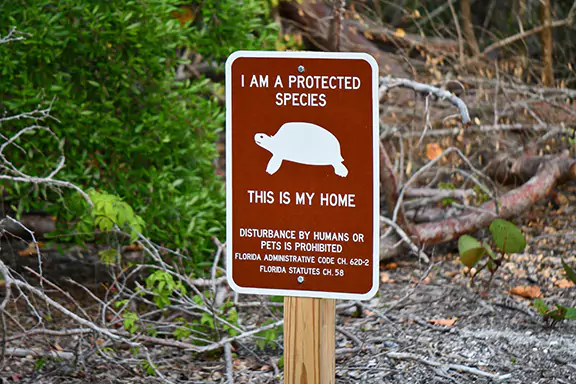
Threats and Conservation Status
Despite its ecological importance, the gopher tortoise faces many challenges in the wild. Over the past several decades, the species has experienced widespread population declines, driven largely by habitat loss, fragmentation, and human activity. Today, the gopher tortoise is listed as a threatened species under Florida law, and efforts are underway to evaluate its status under the federal Endangered Species Act.
The Impact of Habitat Destruction on Gopher Tortoise Populations
One of the biggest threats to gopher tortoises is habitat destruction. As residential, commercial, and agricultural development expands across the southeastern coastal plain, upland habitats like longleaf pine forests and sandy oak hammocks are being cleared, degraded, or altered. These changes eliminate feeding grounds and make it impossible for tortoises to dig or maintain their burrows.
In areas where habitat is fragmented, gopher tortoises face an increased risk of road mortality, isolation from breeding populations, and reduced access to food. As a result, local populations can decline quickly, especially when juvenile tortoises cannot survive long enough to reach maturity.
Another growing concern is upper respiratory tract disease (URTD), a contagious illness that can spread quickly in tortoise populations, especially where individuals are relocated or concentrated in disturbed areas. While not always fatal, URTD can weaken immune systems and reduce reproductive success, exacerbating the impact of habitat stress.
Why Gopher Tortoise Relocation Requires Permits and Expertise
Relocating tortoises, often necessary during construction projects, is a tightly regulated process by the Florida Fish and Wildlife Conservation Commission.
It involves identifying active burrows, securing permits, and moving the tortoises to approved recipient sites with compatible habitats. Improper relocation or unauthorized disturbance of burrows is illegal and can carry significant fines.
In addition to FWC, agencies like the U.S. Fish and Wildlife Service and organizations like the Gopher Tortoise Council play critical roles in conservation efforts. Their work includes population monitoring, habitat restoration, policy development, and public education.
The gopher tortoise’s eastern distinct population segment—covering most of its Florida range—is under review for federal protection status. If listed under the Endangered Species Act, this could bring new conservation tools, funding opportunities, and stricter regulations to support long-term recovery.
Ultimately, the fate of the gopher tortoise revolves around cooperation among private landowners, state and federal agencies, and conservation groups. Protecting their habitat, supporting relocation when necessary, and managing threats like invasive species are all part of the path forward.
10 Fast Facts About the Gopher Tortoise
Looking for quick, need-to-know details about Florida’s most famous burrow builder? Here are some fascinating facts about the gopher tortoise that highlight how unique and essential this species truly is.
1. Scientific Name:
Gopher tortoises belong to the species Gopherus polyphemus and are the only native tortoise species found east of the Mississippi River.
2. Lifespan:
Gopher tortoises can live 40 to 60 years in the wild—sometimes even longer in undisturbed habitats.
3. Size and Appearance:
Adults typically grow 9–15 inches long and have a dark brown, domed shell. Juvenile gopher tortoises are much smaller and lighter in color, making them more vulnerable to predators.
4. Diet:
Gopher tortoises are opportunistic grazers. They feed on broadleaf grasses, legumes, fruits, and flowering plants, helping spread seeds and shape the local ecosystem.
5. Burrow behavior:
Each tortoise digs its burrow, stretching over 40 feet long and 10 feet deep. These burrows offer critical shelter to over 350 other species.
6. Do gopher tortoises bite?
They can bite if mishandled, but they are not aggressive. It’s illegal to touch or move a gopher tortoise without proper permitting.
7. Eggs and hatchlings:
Female tortoises lay 5–9 eggs per clutch, usually in sandy areas near their burrows. Eggs hatch in late summer or early fall, and hatchlings are fully independent from birth.
8. Habitat preferences:
Gopher tortoises live in upland habitats like longleaf pine forests, coastal dunes, and sandy oak hammocks with well-drained soils.
9. Range:
Their range includes much of Florida, southern Georgia, southern South Carolina, and parts of Alabama and Mississippi.
10. Conservation status:
The species is listed as threatened in Florida and is under review for potential listing under the federal Endangered Species Act.
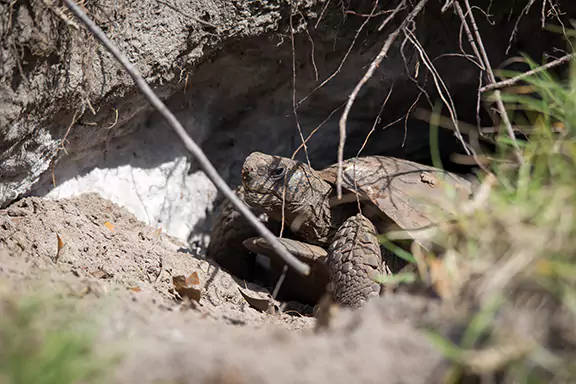
Gopher Tortoises - Protecting a Species Worth Saving
The gopher tortoise isn’t just a symbol of Florida’s wild heritage—it’s a living cornerstone of the ecosystems that stretch across the southeastern United States. From the sandy uplands of the Florida Panhandle to the longleaf pine forests of southern Georgia and South Carolina, these animals quietly shape the land beneath our feet.
As habitat loss, invasive species, and human activity threaten gopher tortoise populations, the responsibility to protect them grows even more urgent. Whether you’re a private landowner, a developer, or simply someone who cares about the future of native wildlife, understanding and respecting the role of the gopher tortoise is a vital first step.
By supporting habitat restoration, advocating for responsible development, and following state and federal guidelines when encountering tortoises on your land, you’re helping preserve an irreplaceable species and the hundreds of other creatures that depend on it.
Have a Gopher Tortoise on Your Property? Need Help Navigating Florida’s Regulations?
Our team specializes in professional surveys, permitting, and relocation services to ensure your project stays compliant and conservation-focused.
👉 Contact Premier Gopher Tortoise Services today to speak with a licensed expert.
Let’s protect wildlife responsibly, legally, and with care.
